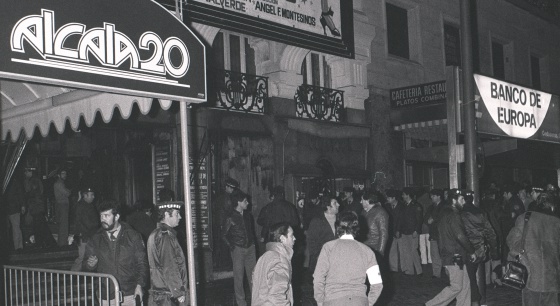
On the morning of December 17, 1983 Madrid awoke to terrible news. A fire at the Alcalá 20 nightclub in the heart of the capital had left 78 people dead. The lack of safety measures at the establishment and the padlocking of emergency exits led to a complete overhaul of safety and security protocols in Spain. Now, 30 years later, the victims and some of the people responsible for the tragedy prefer to forget. The images of that night still haunt them today.
The Alcalá 20 disaster completed a black month for the region of Madrid, where two fatal air crashes had also recently taken place at Barajas airport and Mejorada del Campo: in total, 355 people were killed in the space of a few days. The initial death toll at Alcalá 20 rose to 81 after a person died in intensive care and the bodies of two youngsters were discovered in an elevator shaft inside the building.
It is thought that the fire might have been caused by a short circuit in the electrical system. At around 4.30am that Saturday morning, the stage curtains went up in flames. Cries of "fire, fire" were initially taken as a joke by many clubbers, who remained on the basement dance floor. According to the owners of the club there were 150 people inside at the time, although customers said the figure was closer to 1,000.
The flames created a thick blanket of smoke, causing people to run up the stairs to street level. But the hallway and coat check area were too narrow to cope with the dozens of people rushing madly to escape death. The desperation to get out led to a human stampede in which many people were trampled. The locked emergency doors converted the night spot into a death trap from which dozens of people were unable to escape in time through the one available exit.
It has been a long time, and many people have tried to move on. Purificación A. P. lost a sister in the tragedy. Her father was the janitor of the building located right above the nightclub. She had been sleeping when her parents pulled her out of bed. The house was filling up with smoke.
"It's been very tough. It's been 30 horrible years," she says, tears welling up. "Every single day I remember what happened and it is never out of my mind."
She prefers not to go on. Many other victims and family members did not even let the reporter finish his question: the conversation was over as soon as Alcalá 20 was mentioned.
One of the first people to go inside the nightclub after the fire had broken out was firefighter Francisco Gallego Clavero, who says the place was absolute chaos. One of the first things he remembers about that night is that as soon as he walked in, he saw three bodies lying on a staircase. Later he went downstairs and found "a bunch of people piled up" next to the coat check.
"I was using a vest pocket flashlight of the kind we used to carry back then to light up the place while my colleagues took out the bodies. Outside there were friends and relatives waiting," recalls Gallego, who was 35 at the time. "It was a huge blow, because nearly everybody died of asphyxiation."
Technical reports showed that the staircase leading up to the entrance door turned into a chimney draft that sucked out all the smoke even as customers attempted to escape through it.
Meanwhile, news about the fire spread quickly through the emergency services' radios. Sitting inside one of the patrol cars that reported to Alcalá 20 was Mateo Rivas, a 24-year-old officer who had also recently been to the site of the air crash in Mejorada del Campo. He and his colleague, who were driving a Seat 131 station wagon, picked up a young woman who was injured and drove her to the Provincial Hospital [now the Gregorio Marañón].
"When we were driving by Puerta de Alcalá, they warned us that this center was over capacity, so we ended up driving to La Paz [hospital in the north of the city]," recalls Rivas, who now works in the traffic accident department.
"What struck me the most was all the smoke coming out and the fact that you couldn't even stand at the front door of the nightclub. The firefighters had to go down with breathing equipment."
The investigation was overseen by a very young judge, the 28-year-old Jacobo López Barja de Quiroga, whose work was later described by other jurists as "masterful" and "textbook perfect."
The four club owners were arrested and the trial, which took place 10 years later, found them guilty, as well as the electrician in charge of the installation and the Interior Ministry inspector who should have checked the club's safety measures.
The state took four years to pay damages to the victims.
Friday 20 December 2013
http://elpais.com/elpais/2013/12/19/inenglish/1387459694_048856.html

0 comments:
Post a Comment